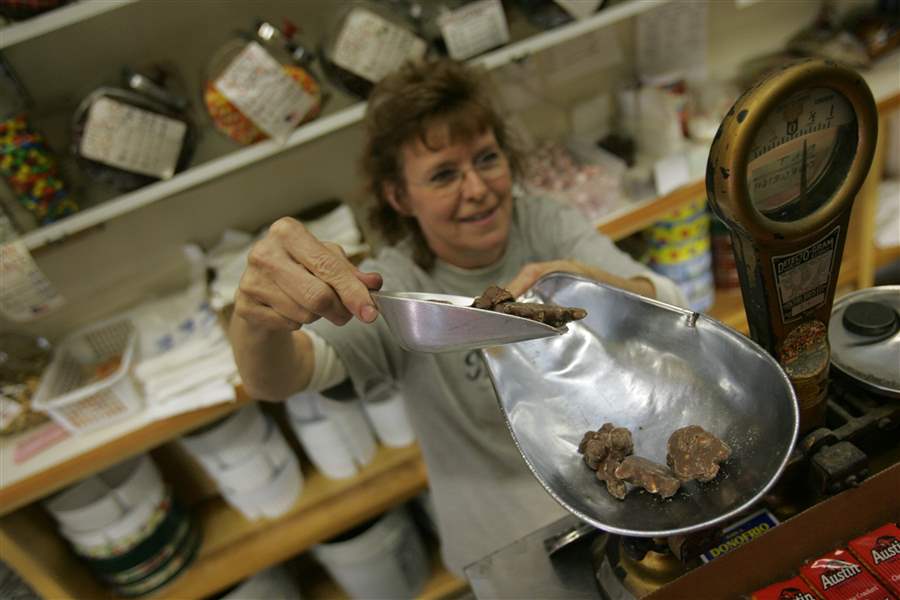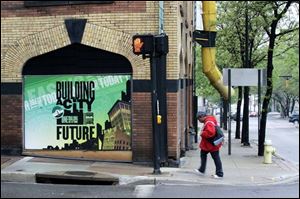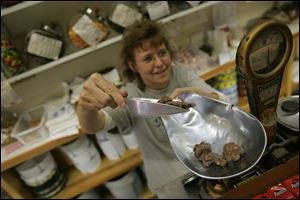
DOWN BUT NOT OUT
Restoration in Akron draws mixed reviews
Empty offices fewest of big Ohio cities
6/24/2008
Marge Klein, owner of the Peanut Shoppe in Akron, operates ‘day to day’ but plans to stay put until developers fi nish all of the projects to see if they attract more customers downtown.
The Blade/Lori King
Buy This Image

In Akron's historic district, a sign touts the city's rebuilding efforts. Government and private investors have put $1 billion into downtown Akron projects over the last 15 years.
AKRON - When problems arise in Akron's city center, members of municipal government's Downtown Operations Group rarely butt out.
The Summit County city was drowning in a sea of cigarette butts tossed onto downtown sidewalks by bar and restaurant patrons forced onto streets by Ohio's smoking ban. Efforts to deal with the issue included placing six dozen cigarette receptacles and free distribution of hundreds of pocket ashtrays.
Deputy Mayor Dave Lieberth, along with the police chief, fire chief, and a dozen other city officials who make up the Downtown Operations Group - DOG for short - are pleased with the results but continue to receive updates on the problem at weekly meetings.
"We aggressively try to clean spaces," Mr. Lieberth explained. "Otherwise it looks like nobody gives a damn about this downtown."
READ MORE: Down But Not Out series
And that strategy, he said, is a key component of efforts to revive the core of the northeast Ohio city that once billed itself as America's rubber capital.
"We manage downtown," Mr. Lieberth said.
Initiatives included enactment of a tough anti-panhandling law with requirements, including one that forces people seeking handouts to register with police.
Mr. Lieberth's boss, Don Plusquellic, Akron's mayor for 21 years, has made downtown restoration a top goal. Over the last 15 years, government and private investors have pumped $1 billion into projects ranging from a new building for the art museum and main library to restoration of historic office buildings.
But along Main Street, the reviews are decidedly mixed.
"Downtown's coming back," exclaimed Kristen Fullerton, a downtown worker for 18 years who lives in nearby Medina.
Countered Brenda Robinson, an administrative assistant in the Summit County prosecutor's office, "It's almost like a ghost town."

She is happy to see more restaurants, a minor-league ballpark opened 11 years ago, and storefront face-lifts. But outside of special events, she said, life is slow in the city core.
"I remember when downtown was hustling and bustling," Ms. Robinson said.
Such characterizations ignore major improvements the last few years, boosters complain.
According to city figures, downtown employment has doubled since the early 1990s to 31,000 people, many of whom are employed at nonprofit hospitals and the University of Akron.
The U.S. Census Bureau counted 492 firms with 12,871 private-sector employees in downtown's main ZIP code as of 2005, according to a report released last year. The tally covers a smaller area than that included in the count by downtown boosters, which helps explain the wide discrepancy in the downtown employment figures.
Still, the Census report shows that Akron was the only major Ohio city whose main downtown work force grew in the first half of the decade, with employment rising 2 percent. Adding two other ZIP Codes that straddle the downtown improvement district - established by merchants under Ohio law - boosts total employment there to 25,954, Census reports show.
Downtown jobs
Major downtown employers include FirstEnergy Corp. - parent of Toledo Edison - which employs 1,360 at its headquarters.
Much of the downtown job growth has come from the public sector, including the university, which has its main campus on the downtown fringes but is usually counted as part of the city core.
It is unclear how many people federal, state, and local government employ downtown. But the U.S. Labor Department says there are 52,000 government workers in metro Akron's 339,000-person labor force.
The University of Akron has been buying up property downtown. Its offices now occupy the former Polsky Department Store building.
Another center of downtown employment is the former headquarters of BF Goodrich. Spread over a dozen buildings on 27 acres, Canal Place includes its own restaurants, deli, day-care center, and gym. Tenants of the office complex, created in the late 1980s, employ a combined 1,600 people.
Akron has a smaller percentage of empty offices downtown than any other major city in Ohio. At 11 percent, the vacancy rate is half that of downtown Toledo. But Toledo has 70 percent more office space downtown.
The metro areas of the two cities are similar, although Akron is slightly larger with 699,356 people. Metro Toledo - including Lucas, Wood, Fulton, and Ottawa County - has a population of 650,955.
Counting only people who live in the city, Toledo is tops with 292,000 residents compared with Akron's 198,000, Census reports show.

Marge Klein, owner of the Peanut Shoppe in Akron, operates ‘day to day’ but plans to stay put until developers fi nish all of the projects to see if they attract more customers downtown.
Sectors struggling
And while downtown Akron boosters are proud of recent achievements, some sectors are struggling.
Few condos or lofts have been built downtown, acknowledged Kimberlee McKee, president of the nonprofit Downtown Akron Partnership.
Northside Lofts, one of the first big residential projects, has 89 condo units priced at $175,000 to $700,000. City officials acknowledge that sales have not been as strong as developers had hoped since the two 10-story buildings were completed last year.
"It opened just as the bottom fell out of the real-estate market," said Mr. Lieberth, deputy mayor. A couple dozen buyers had to back out of purchase contracts when they were unable to sell existing homes, he said.
Still, he said, studies have shown that demand for downtown housing remains strong.
And developers are moving ahead with plans for other projects, he added.
Meanwhile, the $38 million museum of the National Inventors Hall of Fame, which opened to great fanfare in 1995, is reducing exhibit space and being partially converted for use by a new science and technology school, after experiencing declining attendance and financial losses.
When the University of Akron last year purchased and partially converted to dormitories the Crowne Plaza Hotel at Quaker Square, that left just a single downtown hotel.
Hotel half empty
Still, the Radisson City Centre usually operates with less than half its 275 rooms occupied. The company that owns the hotel claims it is insolvent and is seeking partial forgiveness of a loan made by the city of Akron.
Nearby, the Peanut Shoppe, 203 South Main St., is a throwback to another era.
Started in the 1930s as part of a chain of company stores operated by Planters Peanuts, the business still weighs nuts and candies on scales first used during the Great Depression and cooks peanuts in converted coffee roasters purchased by Planters many years ago.
Stored nearby is a Mr. Peanut costume created for promotional purposes in the shop's early years.
Despite brisk business on a sunny spring day and the shop's uniqueness, owner Marge Klein said she operates "day to day."
"It's tough," she complained.
Business took a dive a few years ago when a drugstore next door closed.
"In the cold months people don't come out of their offices," a clerk said. "They drive in in the morning and home at night and don't stop anywhere downtown."
Foot traffic cited
"We depend on foot traffic," interjected the owner. A hopeful note, she said, was the opening in early May of a large Damon's restaurant across Main Street.
"We've considered closing or relocating," Ms. Klein said. "But we're going to wait until developers and the city finish all the projects they have planned to see if that will bring people down here."
Developer Tom Weisse, of Akron's Schipper Group, is more upbeat.
His firm is renovating a three-story office building next to the Peanut Shoppe. Tenants have not yet been found for the structure built in 1901.
But the developers aren't too worried because they operate a profitable four-story office building next door and have announced plans for a seven-story office building nearby, across from Canal Park baseball stadium.
An official of a struggling downtown business that depends on travelers said the new offices and related businesses don't help his firm.
"Akron is a typical Ohio downtown," he said. "The city has made a lot of investments. But it's not necessarily the kind of thing that brings travelers. And travelers who do come to Akron aren't necessarily staying downtown."
Contact Gary Pakulski at:
gpakulski@theblade.com
or 419-724-6082.